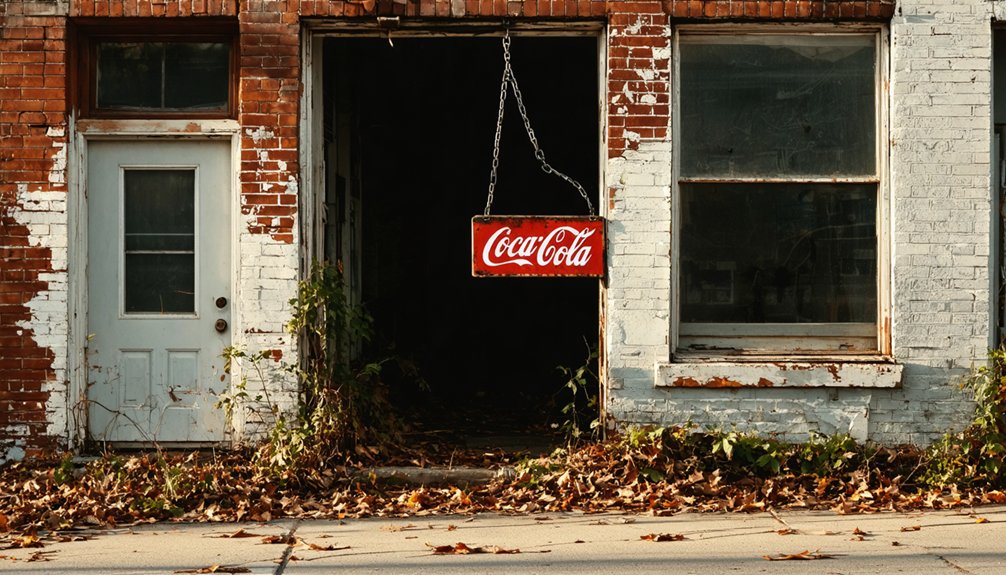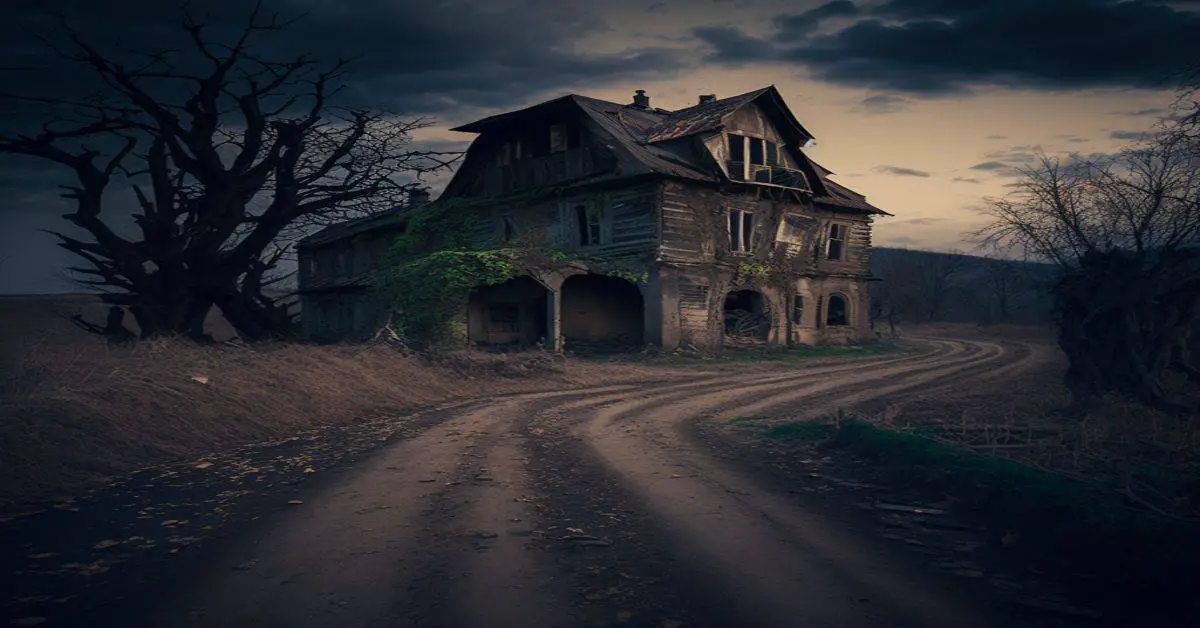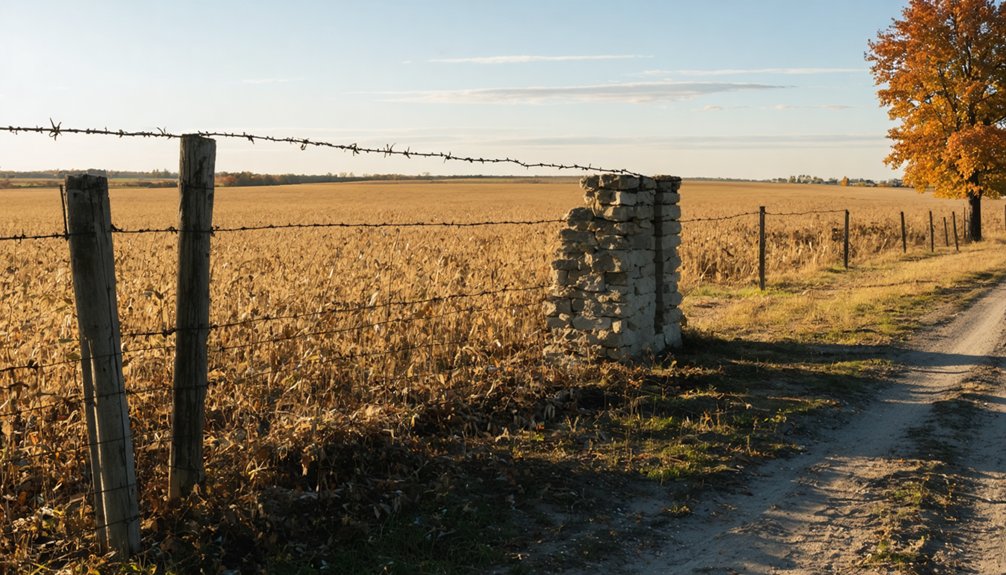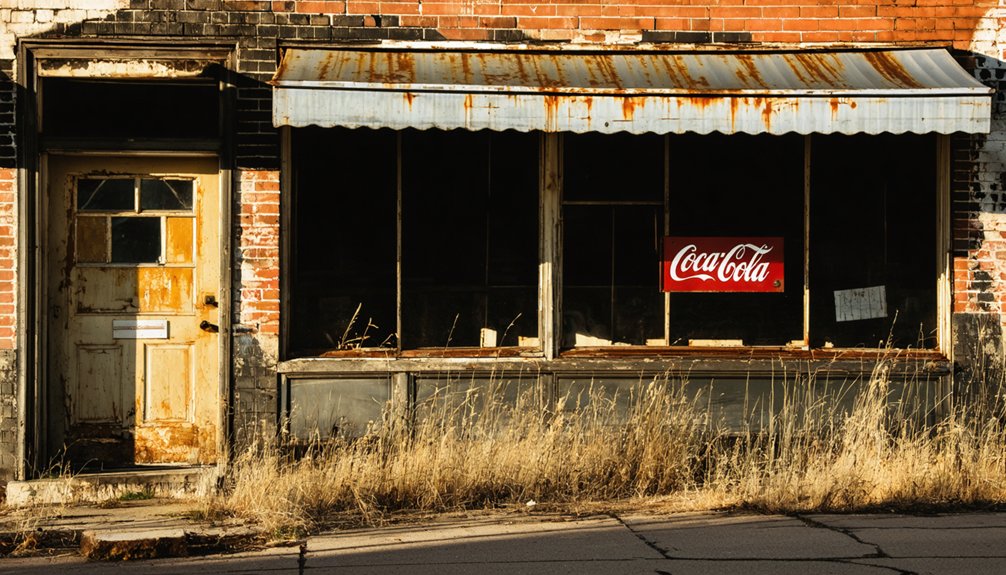You’ll find Milton’s remains in Brown County, Illinois, where Lewis Gay and William C. Ralls established this ambitious river settlement in 1836. The town emerged near McKee Creek and the Illinois River, promoted as a prime location for water navigation and commerce. While it attracted settlers and hosted the Johnson mill, Milton never fulfilled its promise, vanishing within decades. Today, only Milton Cemetery and scattered historical records hint at deeper mysteries of this lost frontier town.
Key Takeaways
- Milton was founded in 1836 as a river commerce hub but failed to thrive due to unrealized navigation benefits and lack of railroad connections.
- The town completely vanished, with no remaining structures, and its location is now primarily agricultural land in Brown County, Illinois.
- Milton Cemetery is the only physical remnant of the settlement, now associated with local ghost stories and folklore.
- The town never established essential infrastructure like schools, churches, or government buildings during its brief existence.
- Milton’s peak population was under 200 residents before declining into a ghost town during the pre-Civil War period.
Historical Origins and Settlement
The rural landscape of western Illinois once held the promising settlement of Milton, founded in 1836 by entrepreneurs Lewis Gay and William C. Ralls.
You’ll find that the founders’ motivations centered on establishing a thriving river commerce hub, as they strategically positioned the town at the head of slack water navigation near the Illinois River.
Like many towns dependent on waterways, such as Griggsville Landing, Milton’s early success relied heavily on river trade and commerce.
The early infrastructure took advantage of the town’s proximity to McKee Creek, where the old Johnson mill already operated. Like other towns of its era, Milton was destined to become one of many Level 4 ghost towns with abandoned business buildings still standing.
Milton’s early settlers wisely built around McKee Creek, making use of the established Johnson mill’s strategic location.
On August 26, 1836, Milton was officially platted, laying the groundwork for what the founders hoped would become a bustling commercial center.
They designed the settlement with a traditional grid system, common in early American towns, and promoted its potential for mills and industrial development along the waterways.
Geographic Location and Landscape
Located at approximately 40.1° N latitude and 90.8° W longitude, Milton’s strategic position near the Illinois River shaped its early development and continues to define its landscape today.
The area’s geographic features include rolling hills and fertile plains that you’ll find typical of Illinois’ western region.
You’ll discover an agricultural landscape dominated by corn and soybean fields, interspersed with scattered woods of oak and maple trees. The rich, nutrient-dense soil has long supported farming operations throughout the surrounding countryside. McKee Creek flows through the area, providing essential water resources for local agriculture.
While the Illinois River brought prosperity through trade, it also introduced flood risks to the area. Like many ghost towns in Illinois, Milton’s development was heavily influenced by its proximity to waterways and transportation routes. The terrain around Milton sits near the head of slack water navigation, with rural roads winding through farmland that stretches as far as the eye can see.
Rise and Decline of Milton
During the late summer of 1836, Lewis Gay and William C. Ralls laid out Milton near McKee Creek, promoting it as a promising settlement at “the head of slack water navigation.” They sold town lots by highlighting the potential for river transport on the nearby Illinois River, just four to five miles away.
Despite their optimistic vision, Milton’s community dynamics never gained momentum. The lack of railroad connections and unrealized river navigation benefits stunted the town’s growth. For researchers seeking information, Milton appears as a disambiguation entry among various other places sharing the same name.
You won’t find records of schools, churches, or government buildings ever developing there. The settlement gradually faded as residents and businesses gravitated toward neighboring towns with better transportation links.
Today, Milton exists only in property plats and local folklore, with stories still circulating about Milton hill – a reflection of the fierce competition faced by early Illinois river towns. Local residents have reported seeing ghostly nightly visits to the abandoned Milton Cemetery, though most thrill-seekers leave disappointed.
Life in Early Milton
Early settlers in Milton embraced a life centered around agricultural pursuits and milling operations, with the old Johnson mill serving as a cornerstone of local commerce. The fertile prairie lands typical of the Northwest Territory provided ideal conditions for farming.
You’d have found the town’s community dynamics shaped by its strategic location near the Illinois River, where Lewis Gay and William C. Ralls established the settlement in 1836. The town’s economic activities flourished around the waterfront, offering opportunities for trade and expansion.
Your daily life would’ve revolved around seasonal harvests, mill work, and riverside commerce. Like many frontier settlements, the community depended heavily on the county seat business for survival. You’d have joined your neighbors for community gatherings, sharing in the challenges of frontier living while building a resilient society.
Frontier life in Milton centered on agriculture and community spirit, as settlers banded together to forge a new existence.
The promise of slack water navigation drew investors and settlers alike, creating a bustling community where families worked together to overcome environmental challenges and build a thriving future.
Legacy and Present-Day Status
While Milton’s physical structures have completely vanished from the Brown County landscape, its historical significance lives on through regional archives and genealogical records.
You’ll find the town’s legacy preserved primarily through historical documentation rather than physical landmarks, as the original townsite has transformed into agricultural land near McKee Creek and the Illinois River.
Community engagement with Milton’s history continues through local research projects and family histories, though there aren’t any standing ruins or markers for on-site historical preservation. Like many hamlet communities in Illinois, Milton had fewer than 200 residents during its peak. Like the old Chicago Burlington Railroad that transformed similar towns, Milton’s development was deeply tied to transportation infrastructure.
The settlement’s story enriches understanding of pre-Civil War Illinois frontier development, particularly regarding river transportation hopes and land speculation.
While you can’t visit any physical remnants today, Milton’s role in Brown County’s early settlement patterns remains an important reference point for historians and genealogists alike.
Frequently Asked Questions
Were There Any Major Disasters or Epidemics That Contributed to Milton’s Abandonment?
While records show no disease outbreaks directly caused Milton’s end, you’ll find one devastating 1843 fire nearby in Brownsville forced relocation, though Milton’s decline stemmed mainly from transportation and economic shifts.
What Native American Tribes Originally Inhabited the Milton Area Before Settlement?
You’ll find the Shawnee primarily controlled this area’s tribal history, while granting Delaware hunting rights and respecting Miami’s cultural significance at Browning Mountain. The Wyandotte established nearby settlements.
Did Any Famous Historical Figures Ever Visit or Stay in Milton?
Like checking Instagram followers in 1836, you won’t find any historical visitors or notable residents who came to Milton. Records show only the town’s founders, Lewis Gay and William Ralls.
What Was the Average Property Value or Cost of Land in Milton?
You’ll find limited records on Milton’s property market, but land prices likely matched regional rates of $1.25-$2.00 per acre for raw land, with town lots potentially selling for slightly more.
Were There Any Documented Criminal Activities or Notable Lawsuits in Milton?
While nearby towns had their share of troubles, you won’t find any documented criminal history or legal disputes in Milton’s records – time and sparse documentation have erased those potential stories.
References
- https://www.youtube.com/watch?v=IeayU8CmF5w
- https://www.youtube.com/watch?v=93k0qtvzkn4&vl=en-US
- https://drloihjournal.blogspot.com/p/lost-towns-of-illinois-series.html
- https://aberdeenmag.com/2019/01/the-ghost-towns-of-brown-county/
- https://drloihjournal.blogspot.com/2022/09/lost-towns-of-illinois-milton-illinois.html
- http://livinghistoryofillinois.com/pdf_files/History of Schuyler and Brown Counties
- https://www.familysearch.org/en/wiki/Brown_County
- https://en.wikipedia.org/wiki/List_of_ghost_towns_in_Illinois
- https://schuyler-ilgw.genealogyvillage.com/OldTimesInSchuyler/OTIStownsites.html
- https://freepages.rootsweb.com/~gtusa/history/usa/il.htm



